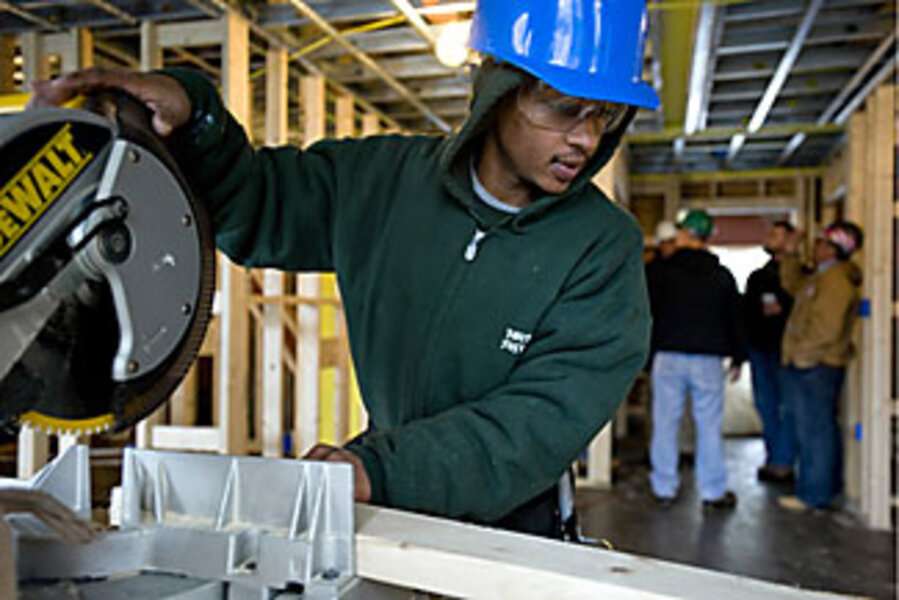YouthBuild: one stimulus model
Loading...
Daniel Brito finished high school, but he didn't know what to do next. His family, in a low-income Boston neighborhood, just wasn't there for him. He was scared he'd be a failure.
Then a former teacher connected him with YouthBuild Boston, a local affiliate of a nationwide program that enables low-income young people to stay with their education and learn job skills while building affordable housing for their communities.
Today, Mr. Brito is a graduate of the program and a union carpenter. "I learned everything there – how to show up on time, how to work with others, to never give up," he says. "Now [I] ... wake up every morning wanting to go to work. I love what I do!"
YouthBuild has opened doors to employment for more than 84,000 youths most often left behind. It's also completed 18,000 affordable housing units in 44 states.
Next week, to celebrate the program's 30th anniversary, participants from across the United States will construct one of their energy-efficient "green" houses on the National Mall in Washington.
Because of YouthBuild's success, the recent stimulus bill included $50 million to expand the program beyond resources already available to it in the Labor Department budget.
The program is directed toward people ages 16 to 24 and aims especially to help high school dropouts and youth offenders.
In a 2008 study of its work with offenders, researchers from Vanderbilt University found that every dollar spent on a YouthBuild participant yielded between $10.80 and $42.90 in benefits to taxpayers. Participants completed their GEDs or high school diplomas at a rate twice the national average for high school dropouts and had a recidivism rate 10 percent lower than other groups studied.
"For so many young people, the first 18 years of their lives haven't worked very well," says Kenneth Smith, executive director of YouthBuild Boston. "They want to embrace an opportunity to change."
At the Boston program, youths learn construction trades, landscaping, or facilities management. They weatherize homes for the elderly in their neighborhoods. Last year, 14 graduates made it into the carpenters union.
Perhaps one secret to the program's success lies in its origin: The idea came from youths themselves.
Back in 1978, Dorothy Stoneman was working with low-income teens in East Harlem in New York and asked them what they would do for their community if they had adult support. The kids said they'd take back abandoned houses from drug dealers, restore them, and give them to homeless families. They began to do just that.
Today, 226 organizations across the US are using the YouthBuild model, and the federal government has provided some grants since 1993. With the stimulus funds, federal money for the program will total $120 million for this year.
"The Obama administration understands that it integrates education, employment, housing, crime prevention, and leadership development," says Ms. Stoneman, the longtime youth champion who heads the national YouthBuild USA office that trains affiliates.
Youths spend 50 percent of their time completing a GED or high school diploma and 50 percent developing workplace and life skills through community service projects.
When the Bill & Melinda Gates Foundation began focusing on education, it recognized YouthBuild's track record.
"We think they are a tremendous organization, and we've been partners with them since 2003, first to improve high school graduation rates, and then to ensure young people also earn the college degree they need to succeed," says Marie Groark, a senior program officer at the foundation. In November, the Gates Foundation gave YouthBuild a $6 million grant as part of its effort to encourage youths to go on to attain postsecondary credentials.
Luis Docanto, who dropped out of school in 10th grade, is now working on his GED at YouthBuild Just-A-Start in Cambridge, Mass. He wants to go on to Bunker Hill Community College and eventually into some form of law enforcement. YouthBuild has become "a second home and a second chance," he says, as he and his co-workers frame a closet at an affordable housing site in Cambridge.
A very shy young man when he entered the program, Mr. Docanto has "really opened up and shows strong leadership skills among his peers," says Lisa Bolstad, a carpentry teacher and site supervisor.
The Cambridge program offers a pre-apprenticeship certificate in construction, as well as a new health careers program. About 75 percent of students go on to graduate from the Cambridge program.
"Knowing how to build a house is half the battle. The other half is having youths become convinced they have potential," says John Bengel, YouthBuild Just-A-Start executive director. "The curriculum is built so people have initial successes, which lead to other successes."
The affordable condominiums in Cambridge are being built according to LEED standards for green buildings, including solar panels on the roof. YouthBuild Boston has just completed two green houses and hopes to earn a gold LEED certificate for them.
With support from the Wal-Mart Foundation, "building green" has become a priority for YouthBuild programs, for environmental reasons and to prepare youths for green careers.






